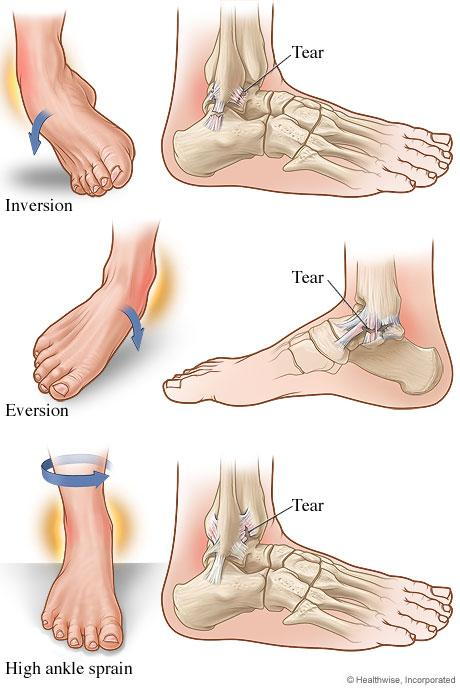Ankle sprains are among the most common injuries affecting the foot and ankle, especially for those who are active in sports or outdoor activities. A sprain occurs when the ligaments in the ankle joint are overstretched or torn due to an unnatural twisting motion. This injury can happen when you walk or run on uneven ground, land awkwardly from a jump, or apply an unusual amount of force to the ankle joint. At Southern Maryland Foot & Ankle, we frequently see patients with ankle sprains, and prompt treatment is essential for proper healing and preventing future complications.
Types of Ankle Sprains
There are three primary types of ankle sprains, categorized based on the direction of the foot’s movement and the ligaments affected:
1. Inversion Ankle Sprain
The inversion ankle sprain is the most common type of ankle sprain, accounting for about 70-85% of all cases. This occurs when the foot rolls inward, causing the ligaments on the lateral side (outside) of the ankle to stretch or tear. The anterior talofibular ligament (ATFL) is often the most affected ligament in this type of sprain.
Key Characteristics:
- The foot turns inward.
- Pain is usually felt on the outer side of the ankle.
- Swelling and bruising may occur on the lateral side of the foot.
2. Eversion Ankle Sprain
Less common than the inversion type, an eversion ankle sprain occurs when the foot turns outward, placing strain on the ligaments on the medial side (inside) of the ankle. The deltoid ligament, which is a strong band of tissue on the inside of the ankle, is typically affected.
Key Characteristics:
- The foot turns outward.
- Pain occurs on the inner side of the ankle.
- Swelling and bruising on the medial side of the ankle.
3. High Ankle Sprain
A high ankle sprain involves injury to the ligaments that join the tibia and fibula, the two long bones in the lower leg. These sprains usually result from a forceful outward twisting of the foot and are common in high-contact sports such as football, rugby, and soccer.
Key Characteristics:
- Pain occurs above the ankle joint.
- Tenderness is felt between the tibia and fibula.
- The injury often involves a longer recovery time compared to inversion or eversion sprains.
Symptoms of Ankle Sprains
The severity of an ankle sprain can vary, but common symptoms include:
- Pain or soreness in the ankle, especially when walking or putting weight on the foot.
- Swelling in the affected area, which may worsen over time.
- Bruising around the ankle or foot.
- Difficulty walking or an inability to bear weight.
- Stiffness and limited range of motion in the ankle joint.
These symptoms can range from mild to severe, depending on how much the ligament was stretched or torn. Without prompt treatment, an ankle sprain can lead to chronic instability, making future sprains more likely and leaving the ankle feeling weak or unstable.
Why Prompt Treatment is Essential
Many people underestimate ankle sprains, thinking they will heal on their own with time and rest. However, delaying treatment can lead to complications such as chronic ankle instability, recurrent sprains, or more serious injuries like fractures. When left untreated, the damaged ligaments may not heal properly, resulting in long-term discomfort and weakness in the ankle.
Treatment Options for Ankle Sprains
If you suspect an ankle sprain, it is crucial to seek medical attention. At Southern Maryland Foot & Ankle, our board-certified foot and ankle surgeon will conduct a thorough examination to determine the severity of the injury and recommend the best course of treatment.
Here are some common treatment options:
- Rest, Ice, Compression, and Elevation (RICE):
- Rest the ankle to prevent further injury.
- Apply ice packs to reduce swelling.
- Use compression bandages to support the ankle.
- Elevate the ankle above the heart to minimize swelling.
- Immobilization: In moderate to severe cases, the doctor may recommend using a brace, boot, or crutches to immobilize the ankle and prevent further damage while it heals.
- Physical Therapy: Once the initial pain and swelling have subsided, rehabilitation exercises may be prescribed to restore strength, flexibility, and stability to the ankle. Physical therapy is essential to regain full function and prevent future sprains.
- Surgical Intervention: In severe cases where the ligaments are completely torn, or if chronic instability persists, surgery may be necessary to repair the damaged ligaments.
Preventing Future Ankle Sprains
Preventing future sprains is critical, especially for athletes or individuals with a history of ankle injuries. Here are some tips to help reduce the risk:
- Wear proper footwear: Choose shoes that provide adequate support for your activities, especially in sports that involve a lot of sudden movements.
- Strengthen your ankle muscles: Regular exercises that target the muscles around the ankle joint can improve stability and reduce the risk of sprains.
- Be cautious on uneven surfaces: Walking or running on uneven ground can increase your risk of rolling your ankle.
- Use ankle braces or tape: If you have a history of ankle sprains, wearing an ankle brace or taping your ankle during physical activities can provide extra support.
Conclusion
Ankle sprains are common, but they require proper care to prevent long-term complications like chronic instability or recurring sprains. If you’ve injured your ankle, don’t wait—seek prompt medical attention to ensure a full recovery. At Southern Maryland Foot & Ankle, our team of experts are here to help you get back on your feet as quickly and safely as possible.
If you’re experiencing symptoms of an ankle sprain or want to learn more about prevention and treatment, contact any of our offices to schedule an appointment today!

